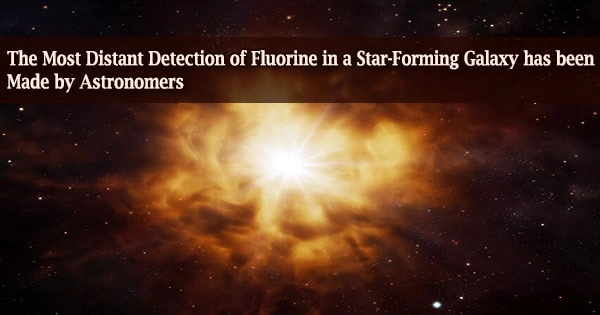A new study sheds light on how fluorine, which is found in our bones and teeth as fluoride, is formed in the Universe. A team of astronomers has identified this element in a galaxy that is so far away that its light has taken almost 12 billion years to reach us using the Atacama Large Millimeter/submillimeter Array (ALMA), in which the European Southern Observatory (ESO) is a partner. This is the first time fluorine has been discovered in a star-forming galaxy so far away.
“We all know about fluorine because the toothpaste we use every day contains it in the form of fluoride,” says Maximilien Franco from the University of Hertfordshire in the UK, who led the new study, published today in Nature Astronomy.
“Like most elements around us, fluorine is created inside stars but, until now, we did not know exactly how this element was produced. We did not even know which type of stars produced the majority of fluorine in the Universe!”
Franco and his colleagues discovered fluorine (in the form of hydrogen fluoride) in the massive gas clouds of NGP-190387, which we see as it was when the Universe was only 1.4 billion years old, or roughly 10% of its current age.
Because stars expel the elements they make in their cores as they die, this discovery means that the stars that created fluorine lived and died fast.
The team believes that Wolf-Rayet stars, which are extremely massive stars that survive for only a few million years, or a fraction of a second in the history of the Universe, are the most plausible sources of fluorine. They say they’re needed to explain the levels of hydrogen fluoride found by the scientists.
Although Wolf-Rayet stars had previously been mentioned as possible sources of cosmic fluorine, astronomers did not realize how essential they were in the early Universe until now.
For this galaxy, it took just tens or hundreds of millions of years to have fluorine levels comparable to those found in stars in the Milky Way, which is 13.5 billion years old. This was a totally unexpected result. Our measurement adds a completely new constraint on the origin of fluorine, which has been studied for two decades.
Chiaki Kobayashi
“We have shown that Wolf-Rayet stars, which are among the most massive stars known and can explode violently as they reach the end of their lives, help us, in a way, to maintain good dental health!” jokes Franco.
Other theories on how fluorine is created and expelled have been proposed in the past, in addition to these stars.
Pulsations of large, evolved stars with masses up to a few times that of our Sun, known as asymptotic giant branch stars, are one example. However, the researchers feel that these scenarios, some of which require billions of years to play out, may not adequately explain the fluorine content of NGP-190387.
“For this galaxy, it took just tens or hundreds of millions of years to have fluorine levels comparable to those found in stars in the Milky Way, which is 13.5 billion years old. This was a totally unexpected result,” says Chiaki Kobayashi, a professor at the University of Hertfordshire.
“Our measurement adds a completely new constraint on the origin of fluorine, which has been studied for two decades.”
The discovery of fluorine beyond the Milky Way and its neighboring galaxies in NGP-190387 is one of the first of its kind.
This element has previously been discovered in quasars, brilliant objects fueled by supermassive black holes at the heart of some galaxies. But this element had never been seen in a star-forming galaxy so early in the Universe’s history.
The finding of fluorine by the scientists was a happy accident made possible by the utilization of space and ground-based observatories. NGP-190387 is exceptionally brilliant for its distance, having been detected with the European Space Agency’s Herschel Space Observatory and then spotted with the Chile-based ALMA.
The ALMA data indicated that another known large galaxy, lying between NGP-190387 and the Earth and quite near to the line of sight, was partly responsible for NGP-190387’s remarkable luminosity.
This enormous galaxy enhanced the light seen by Franco and his colleagues, allowing scientists to see the feeble radiation generated by fluorine in NGP-190387 billions of years ago.
Future investigations of NGP-190387 with the ESO’s new flagship project, the Extremely Large Telescope (ELT), which is currently under construction in Chile and is expected to begin operations later this decade, could disclose even more secrets about this galaxy.
“ALMA is sensitive to radiation emitted by cold interstellar gas and dust,” says Chentao Yang, an ESO Fellow in Chile. “With the ELT, we will be able to observe NGP-190387 through the direct light of stars, gaining crucial information on the stellar content of this galaxy.”





